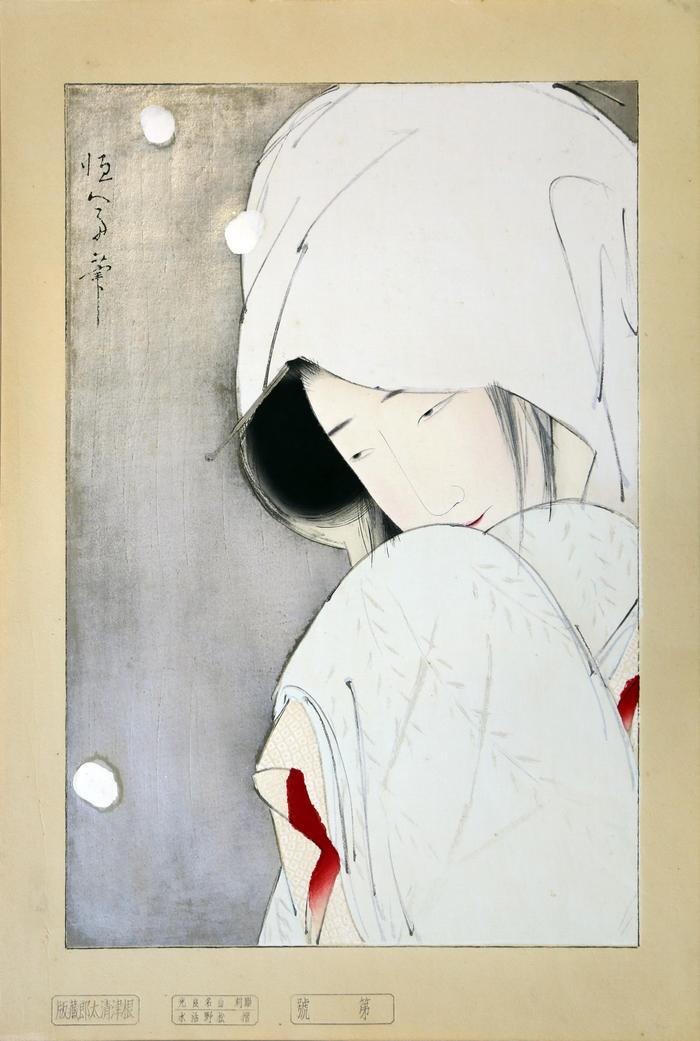Kitano Tsunetomi (北野恒富) (artist 1880 – 1947)
Heron Maiden (Sagi Musume - 鷺娘) - Winter (fuyu 冬) from the series Shiki bijin ('Beauties of the Four Seasons' - 四季美人?)
1925
14.25 in x 21.25 in (Overall dimensions) Japanese woodblock print
Signed: Tsunetomi hitsu (恒富筆)
Publisher: Nezu Seitarō (根津清太郎)
Printer: Matsuno Kassui (摺松野活水)
Carved by: Chōkoku: Yamana Yoshimitsu
(彫刻:山名良光)
Seal at bottom center: Go...dai
'Not numbered'
Harvard Art Museums
Los Angeles County Museum of Art
Legion of Honor, San Francisco
National Museum of Asian Art - from the Robert O. Muller Collection
Art Gallery of New South Wales
Portland Art Museum
Lyon Collection - another version of this print by Tsunetomi
St. Louis Art Museum In Taishō Chic : Japanese Modernity, Nostalgia, and Deco it says on page 104 it says: "The Heron Maiden or Sagi musume was both a frequent pictorial subject in bijinga of the 1920s and 1930s and the subject of a popular Kabuki play. The dance drama (shosagoto) was originally performed in 1762 at Edo’s Ichimuraza, and it likely derived from old shrine dances as well as from folk tales. In this transformation work (hengemono), a woodcutter saves a white heron and takes it home. Soon afterward, a beautiful young woman — the spirit of the heron — arrives at the impoverished woodcutter’s house. She takes pity on him, and they marry. One night she offers to help him earn some money, then retires to another room with the admonition that he must not look at her. There she transforms herself into a beautiful heron and weaves a cape of white feathers plucked from her own skin. The next day she gives her husband the cape, he sells it and greedily asks her for another garment. Unable to refuse him despite the pain it causes, she makes cape after cape until she has plucked every feather from her body. As she lies bleeding, the woodcutter breaks his promise and enters the room. In the climax, the woodcutter realizes that his greed has nearly killed his beloved, and lie returns the heron to the wild."
"The play was revived as a one-act dance by Ichikawa Danjuro II in 1886, featuring a famous “quick-change” of costume as the heron reverts back to the young woman."
"The themes of transformation, beauty, and sacrifice appealed to female audiences who could likely find parallels in their own dreams, if not in their lives. Wraithlike women were common in Taishō art and popular illustration — particularly in designs by Takehisa Yumeji — so it is not surprising that this poignant tale of a female spirit should have found favor on stage as well as in pictures. As a personification of purity, represented by the whiteness of snow, the Heron Maiden is usually imbued with an almost ethereal elegance."
****
"Wraith prints" such as this were made in the few years immediately following the great earthquake of of 1923. The women represent ideals of ethereal beauty and self sacrifice as direct contrast to prints of more modern, physical, and realistic women ("moga"). - K. Brown
During the 1980s, the Japanese publisher Ishukankokai recarved the blocks for Heron Maiden and issued a posthumous edition, also limited to 100 prints - publisher information is printed in the left margin in this later edition.
****
Illustrated:
1) in black and white in 近代日本美人画展 : 伝統木版画を支えた作家たち Exhibition of Modern Japanese Beauties: Meiji, Taishō, Shōwa, Riccar Art Museum, 1982, n.p., no. 64.
2) in color in Burlington Magazine, vol. 153, #1296, March 2011, n.p.
3) color in The Female Image: 20th century prints of Japanese beauties, Abe Publisher, 2000, #108, p. 87.
4) in black and white in Light in darkness : women in Japanese prints of early Shôwa (1926-1945); curators, Kendall H. Brown, et al., Fisher Gallery, University of Southern California, 1996, p. 51.
5) in color in René Scholten's Personal Collection, Audap & Associés (an auction catalog), October 18, 2024, #123 page 84.
****
There is another copy of this print in the St. Louis Museum of Art.
****
Of the examples linked above only the copy at Harvard has a red seal just below the signature in the upper right corner. All of the others are like this example in the Lyon Collection.
****
Notice the palely printed branches of a willow tree trailing down on her sleeve. Note also that it is an obaiban (大倍判) or 'double oban' in size.
Nezu Seitarō (根津清太郎) (publisher)
Kyōto-Osaka prints (kamigata-e - 上方絵) (genre)
beautiful woman picture (bijin-ga - 美人画) (genre)
modern prints (shin hanga - 新版画) (genre)
mitate-e (見立て絵) (genre)
Taishō era (大正時代) (genre)
